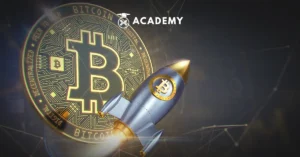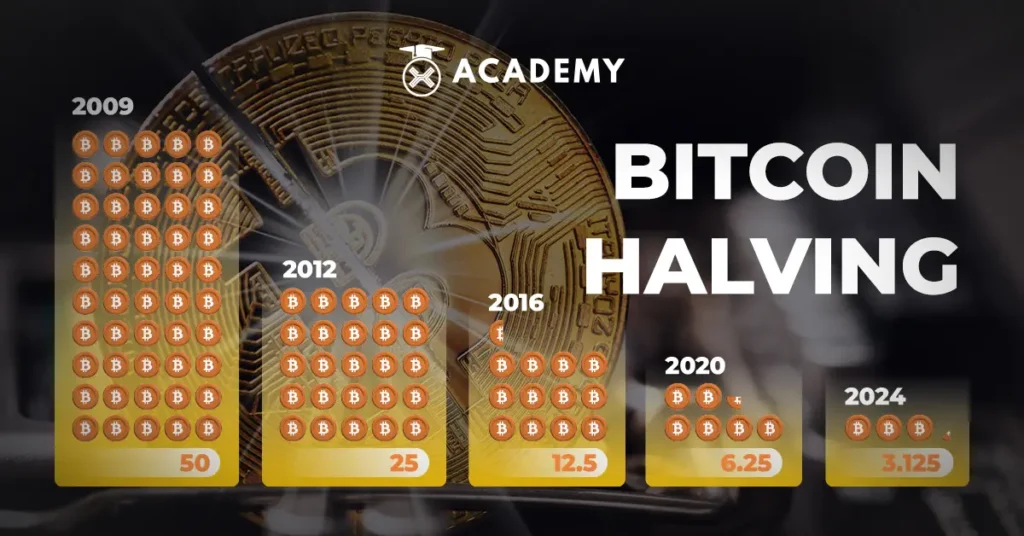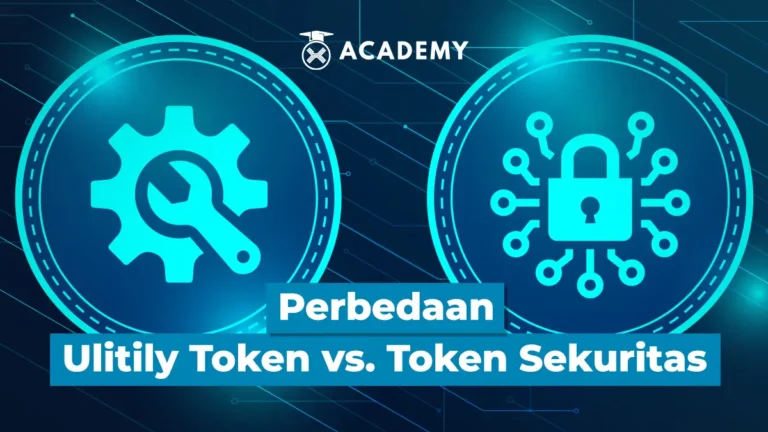Every four years, crypto asset investors witness an important event called bitcoin halving day.
In the world of crypto assets which is often filled with large price fluctuations and great opportunities for profit, halving day is a moment that is eagerly awaited and is considered a crucial factor in achieving success for crypto asset investors.
The halving event is a highly anticipated moment because it is expected to push Bitcoin prices up. This is caused by a decrease in Bitcoin supply following the halving, resulting in a perception of Bitcoin scarcity and potentially a positive driver for Bitcoin prices.
What is Halving Day?
Halving day is the time when the reward block in a crypto protocol is reduced by half or 50 percent. This indicates that the number of new coins created as rewards for miners has halved.
Halving in the world of crypto assets involves halving the rewards earned by miners. The purpose of halving is to maintain the scarcity of a crypto asset, such as Bitcoin.
With the halving, the number of new coins entering circulation remains limited, which in turn is expected to encourage an increase in the value of the asset. Halving Bitcoin is a halving of mining rewards, with the aim of maintaining asset scarcity.
With the halving, the number of new Bitcoins entering circulation remains controlled, thereby increasing the potential for an increase in asset value. The main goal of halving is to regulate the supply of Bitcoin.
By reducing the reward for mining new blocks, the rate of new Bitcoin production slows. This helps control inflation and maintain the stability of Bitcoin’s value.
History of Halving Day: How and When Did It Happen?
Reducing rewards from mined blocks has been part of the plan since Satoshi Nakamoto, the mysterious creator of Bitcoin, published a white paper for this crypto asset on October 31, 2008.
This white paper is a document that first introduced the concept of digital assets, which later became known as the crypto asset Bitcoin (BTC). Halving day in the world of crypto assets was first introduced by Bitcoin.
On the first halving day that occurred in 2012, the reward for bitcoin miners was reduced to 25 bitcoins. Then, the reward was reduced to 12.5 bitcoin on the second halving day of 2016.
On the third halving day which occurred on May 11 2020, the reward for miners was reduced to 6.25 BTC. If we continue with the history of halvings then the next halving is expected to occur in 2024 with the reward for miners being 3,125 BTC.
9 Things You Need to Do After the Bitcoin Halving

After the bitcoin halving, there are several things that traders and investors need to do, including the following:
1. Convert to Bitcoin
After a halving occurs, Bitcoin prices tend to increase because the supply decreases. This is why investors and traders may be interested in buying Bitcoin before or after the halving event.
If you don’t have Bitcoin yet then buying it before the price increase occurs could be a wise move.
2. Pay Attention to Trends
Before and after the halving, Bitcoin prices may experience fluctuations. Historical data shows that Bitcoin prices tend to be lower before the halving and increase afterward.
3. Study Technical Trends
Technical factors, such as support and resistance, trends, and technical indicators, can influence Bitcoin price movements. You can deepen your understanding of these technical trends and use them to make better investment decisions.
4. Study Crypto Project Announcements
Bitcoin halving is an important event that can influence the market. However, apart from halving, there are also various other events that have the potential to influence the market, such as announcements regarding crypto projects.
5. Pay Attention to Economic Conditions
Economic conditions, including inflation, fluctuations in the price of goods, and low income levels, can impact the price of Bitcoin.
6. Study Economic Indicators
Economic indicators, such as GDP, GRDP, and Per Capita Income, can influence the price of Bitcoin. You can deepen your understanding of these economic indicators and use them to make better investment decisions.
7. Study Market Trends
Market movements, including trends in the stock, forex, and commodity markets, can have an impact on the price of Bitcoin. You can study market trends and utilize them in your investment decision-making process.
8. Study Global Market Trends
Global market movements, such as trends in European, Asian and American markets, can influence Bitcoin prices. You can deepen your understanding of global market trends to help in making investment decisions.
9. Study Halving Trends
Halving changes, including Bitcoin halving, Ethereum halving, and other crypto asset halvings, can impact the price of Bitcoin. You can deepen your understanding of this halving trend and integrate it into your investment decision-making process.
Economic Impact of the Halving on Bitcoin

Quoting the blockpit.io page, the economic impact of the Bitcoin halving is enormous, highlighting the deflationary design and its impact on market dynamics. Historically, halving events have often correlated with bullish trends in Bitcoin prices.
This pattern is primarily caused by a decrease in the rate of new Bitcoin creation, which causes supply to become more limited at a time when demand remains stable or increases.
Such inadequacies could increase Bitcoin’s appeal as a digital store of value, compared to precious metals such as gold.
Additionally, anticipation and speculation surrounding these events often amplifies market activity and investor interest, further influencing price movements.
The cyclical interaction between halving events and market dynamics highlights the delicate balance between supply and demand in the Bitcoin economy, strengthening its position as an attractive investment vehicle in the broader financial landscape.
Halving Day Effects on Bitcoin Miners
Quoting the time.com page, although determining the impact of the halving on the average Bitcoin investor is challenging, it seems certain that the halving will dramatically change the Bitcoin mining industry.
Bitcoin “miners” are essentially the guardians of the network, protecting the network from attacks, creating new Bitcoins, and earning financial rewards in return for their actions.
After the halving, the reward for miners for processing new transactions will be reduced from 6.25 Bitcoins to 3,125 (approximately $200,000)—an immediate, significant reduction in revenue.
As a result, mining will become unprofitable for many small operations. When they go out of business or sell themselves to large operations, such as Marathon Digital Holdings Inc. or CleanSpark Inc., the industry is likely to consolidate.
“People are going to operate in a slightly profitable environment for as long as possible,” said Adam Sullivan, CEO of Bitcoin mining company Core Scientific. “Those are the people who will probably be looking to buy, probably in the 6 to 12 month time frame. ”
However, Bitcoin mining companies that survive and gain market share from those that pull out could reap huge rewards, said Matthew Sigel, head of digital asset research at global investment manager VanEck.
“Miners have always been cockroaches in the energy market; they are very agile,” he said. “We think the second half of the year will be very strong for Bitcoin miners, as long as Bitcoin prices are on the rise.”
The Last Bitcoin Halving Event is Estimated to Occur Around 2140
Quoting the blockpit.io page, the last Bitcoin halving event is expected to occur around 2140, marking the end of new Bitcoin emissions with the mining of the 21,000,000th Bitcoin.
The network will shift to relying entirely on transaction fees as an incentive for miners.
The long-term effects on Bitcoin’s price, security, and Bitcoin’s role in the global financial system remain the subject of speculation and depend on a variety of factors, including technological developments and broader economic conditions.
List of Other Crypto Assets that Implement the Halving System
Quoting the bitget.com page, apart from Bitcoin, there are several other crypto assets that also implement the halving system. The following is the complete list, including:
1. Litecoin Halving
Created by Charlie Lee, a former Google engineer and Director of Engineering at Coinbase, in October 2011, Litecoin is often considered the “silver” to Bitcoin’s “gold.” It operates on a decentralized and open source global payment network.
Lee aims to overcome some of Bitcoin’s limitations, resulting in faster transaction confirmation times for Litecoin and making it more suitable for everyday transactions.
Litecoin halving, like Bitcoin halving, is a predetermined event where the block reward decreases approximately every four years or after every 840,000 blocks. This cycle is projected to continue until 2142.
Although its impact on the market is less pronounced than Bitcoin, LTC typically experiences increased trading volume and price volatility leading up to a halving event.
2. Bitcoin Cash Halving
Bitcoin Cash emerged in August 2017 from a hard fork of the Bitcoin blockchain. Known for processing over 100 transactions per second due to its larger block size, BCH offers a decentralized currency system, with an emphasis on peer-to-peer electronic payments.
Bitcoin Cash’s first halving occurred in April 2020. Contrary to expectations, BCH’s halving did not coincide with Bitcoin’s because it uses a different mining algorithm, resulting in an accelerated block mining rate and an earlier halving date.
However, right after the halving event occurred, BCH experienced almost 2 hours of silence before the next block was mined. Although Bitcoin Cash is capable of handling around 116 transactions per second, this figure drops drastically to just 1.11 TPS.
This is because BCH uses the same mining mechanism as Bitcoin so miners can easily switch to other coins.
This resulted in a large number of miners leaving the Bitcoin Cash network to seek better returns elsewhere.
As a result, the mining difficulty level increases, making it less profitable for miners who continue to mine BCH tokens. Therefore, the upcoming BCH halving event could be very controversial.
3. Bitcoin Vision Satoshi (Bitcoin SV) Halving
Bitcoin SV (BSV), originating from BCH, it was created in November 2018, by a group led by Craig Wright, who claims to be Satoshi Nakamoto.
BSV’s unlimited block size, reaching up to 4GB, enables low and stable transaction fees. This unlimited block size allows miners to choose the block size they want.
However, this flexibility carries the risk of centralization and vulnerability to attack, as was proven in an incident in October 2022 in which an unknown miner controlled more than 51% of the hash power.
4. Dash Halving
Dash is an open source crypto asset that emerged in 2014, forked from the Bitcoin protocol. It functions as a decentralized autonomous organization (DAO) and is managed by “masternodes” (powerful servers backed by collateral held in Dash, and designed to provide sophisticated services and governance on the blockchain).
In contrast to the sudden halvings of other crypto assets, Dash experienced a gradual decline of approximately 7.14% approximately every 383.25 days.
5. Zcash Halving
Developed by experts from MIT and Johns Hopkins, Zcash stands out for its privacy technology, which offers confidential transactions. Zcash has a unique reward allocation.
When it launched, Zcash established a reward allocation plan called Founder’s Reward (FR) to fund Zcash development. According to the reward plan, 80% (5 ZEC) of the mining rewards will go to the miners, while 20% will be distributed among the founders and investors of Electric Coin Company.
After the FR ends, the community votes and agrees that miners will receive 80% of the mining rewards.
The remaining 20% will be split between grants to fund independent third-party developers (8%), Electric Coin Co (7%), and the Zcash Foundation (5%), which helps sustain miners mining ZEC.
Conclusion
In conclusion, halving days are important events in the Bitcoin ecosystem because they have a major impact on the supply and demand of this asset.
By halving rewards for miners, halving days limit the supply of new Bitcoins entering the market.
That in turn could lead to an increase in Bitcoin’s value. Historically, halving days are often associated with an upward trend in Bitcoin prices.
Furthermore, for all crypto market players, a good understanding of halving day events is very important.
In this case, Bitcoin investors, traders and users need to understand how the halving day affects market dynamics and how they can exploit it to their advantage.
By paying attention to these events and carefully analyzing their impact, market players will hopefully be able to make better investment decisions and optimize their results in the dynamic crypto market.
Buy Bitcoin on INDODAX
So, now you understand what a Bitcoin halving day is, from history to what to do after Bitcoin halving day.
Next, if you are interested in buying bitcoin then you can buy it at INDODAX. Before buying bitcoin on INDODAX, you can check the price first and make a purchase on the INDODAX Market.
For your information, INDODAX is the best crypto buying and selling platform and is a pioneer in trading crypto assets in Indonesia.
INDODAX is also committed to always providing easy access for investors to the crypto asset market.
Furthermore, as a disclaimer, it needs to be emphasized again that, like other types of investment, crypto asset investment is not free from risk.
This is because the asset value fluctuates and the level of volatility is high. Therefore, it is highly recommended to do research first before investing in crypto assets.
So, let’s start investing in your crypto assets now only on INDODAX!








